Knee arthroscopy – information for you after your operation
Read our guide below which explains what to expect after your knee arthroscopy operation.
You can also download a PDF version of this patient information by following the link on the right.
What is a knee arthroscopy?
It’s a surgical procedure where we insert a small camera through small holes made at both sides of your knee to examine tissues inside the knee joint. We may need to insert additional instruments to repair the knee if necessary.
Will it be painful?
Your knee will feel sore afterwards. Take painkillers as instructed. If you continue to have severe pain or notice excessive bleeding, contact your GP. If the wound looks inflamed, contact your consultant.
The dressing
When you return from the operating theatre, you’ll have a large bandage covering your knee. You can remove it 2 days after the operation or a practice nurse will do it for you.
After removing the bandage, you’ll wear a Tubigrip support, which we’ll give you, during the day for about 2 weeks.
Keep your wounds clean and dry. The nursing staff will give you specific advice about your dressing before discharge.
If you have any questions when you’re back at home, call the Day Surgery Unit on 01494 425581.
Swelling
Your knee may swell, especially as you start to perform exercises and put weight through your operated leg. It’s common for the knee to be swollen and feel stiff for a few weeks.
Remember to elevate your leg when sitting. If necessary, apply an ice pack wrapped in a damp cloth around your knee for 10 minutes each hour until the symptoms ease.
When can I return to sport?
This depends on the demands that it will put on your knee.
If your sport is gentle on your knee, you can return as soon as you can perform all the exercises we give you easily and without pain.
You can swim or do light cycling after your wound has healed.
You can start jogging after 2 weeks as long as you’re pain free and your knee is no longer swollen. This will speed up your rehabilitation. You should do this before restarting more vigorous sports.
If you play rugby, squash, football, hockey, badminton, or karate you must be able to, without pain:
- jog on the spot
- hop on your operated leg
- squat fully
- run on rough terrain up and down hills
- sprint, starting suddenly and stopping suddenly
- lift the same weight, the same number of times as your non-operated leg can lift.
You should only restart your sport when you feel your knee copes with the stress of training.
If you have any problems call the Day Surgery Unit.
When can I drive?
You can usually drive for short periods after 2 to 5 days if your knee is pain free and you can control the car with the foot pedals and do an emergency stop.
Before you restart driving, contact your insurance company and check that your cover hasn’t been affected.
When can I return to work?
If your job is sedentary and involves mostly sitting, you can return after only 2 days. If your job is physically demanding and requires standing or walking for most of the day, your return to work may take 1 to 2 weeks.
If you’re concerned, talk to your doctor.
When do I return to see the doctor?
Usually 4 to 6 weeks after your operation. Hopefully by this stage you should have a full range of knee movement. If you feel your knee isn’t improving, the doctor may refer you for physiotherapy.
Will I be able to walk unaided after the arthroscopy?
You can walk without a stick or crutches after the operation. If your knee is very painful we may give you crutches until it’s more comfortable. Once you can walk without too much discomfort, stop using the crutches and return them to the physiotherapy department.
Try to walk as normally as possible. Don’t walk more than necessary for the first 24 hours, and then gradually increase the amount you do.
Sitting and standing
When sitting, elevate your leg to prevent or reduce swelling.
When standing for any length of time, brace your knee back to help the muscles gain strength. You should avoid standing for long periods for the first 2 weeks.
Climbing stairs
Try stepping up with your non-operated leg first and then take the operated leg up to the same step. Repeat this sequence for each stair.
Coming downstairs, step the operated leg down first and then join it with your non- operated leg. If you’re using a crutch or stick to help you on the stairs, this should come last when stepping up and go first when coming down.
What exercises should I do at home?
The following exercises will help you maintain the increased range of movement in your knee post-operatively. To get maximum benefit we recommend that you:
- use painkillers to reduce pain before you exercise
- use ice packs to control swelling after you exercise
- do short, frequent sessions instead of one long session.
How often should I do the exercises?
Repeat each exercise below 10 times.
Complete the whole set of exercises 3 to 4 times daily.
Early exercises up to 48 hours after your operation
Keep your bandage on for these exercises.
Exercise 1
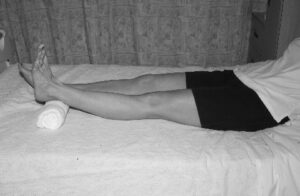
Lie on your back with the small towel roll under your ankle.
Push your knee down to the bed.
Hold for a count of 5, then relax.
Exercise 2
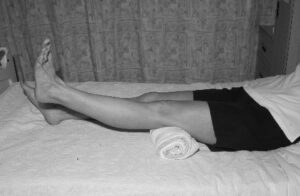
Lie with a large towel roll under your knee.
Keep the back of your knee on the roll and straighten your knee to lift your foot off the bed.
Hold for a count of 5, then relax.
Exercise 3
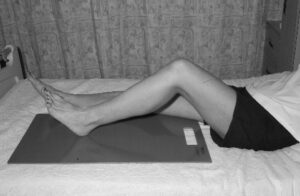
Lie on your back with your operated leg resting on a smooth surface.
Bend your hip and knee by sliding your heel towards your bottom.
Hold for a count of 5, then relax.
Exercise 4
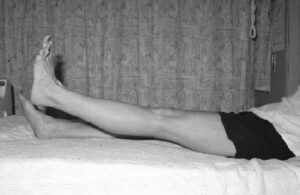
Lie on your back with your non-operated leg in a comfortable position.
Lift your operated leg up approximately 6 inches. Keep the knee straight.
Hold for 5 seconds, then slowly lower back down to the bed.
Advanced exercises after 48 hours
You can remove your bandage for these exercises.
Exercise 1
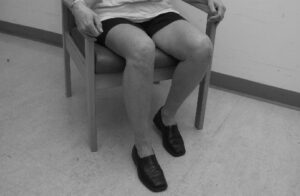
Sit with your foot on the floor.
Slowly slide your foot back as far as possible.
Hold for a count of 5 and then relax.
Exercise 2
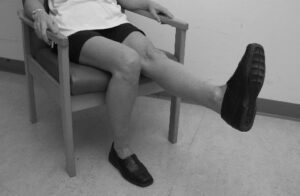
Sit with your thigh supported.
Lift your foot up to straighten the knee
Hold for a count of 5 and then return your foot slowly to the floor.
Exercise 3
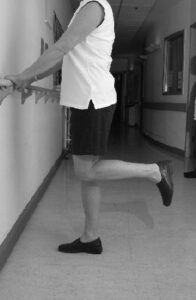
Either lie on your front or stand at a supportive surface.
Bend your knee by lifting your heel up towards your bum.
Don’t move your thigh forward.
Hold for a count of 5.
Slowly lower your foot back to the floor.
How can I help reduce healthcare associated infections?
Infection prevention and control is important to the wellbeing of our patients so we have procedures in place. Keeping your hands clean is an effective way of preventing the spread of infections.
You, and anyone visiting you, must use the hand sanitiser available at the entrance to every ward before coming in and after you leave. You may need to wash your hands at the sink using soap and water. Hand sanitisers are not suitable for dealing with patients who have symptoms of diarrhoea.
More help or advice
Contact our patient advice and liaison service (PALS) on 01296 316042 or bht.pals@nhs.net
About our patient information leaflets
This patient advice is intended as general information only. We aim to make the information as up to date and accurate as possible, but please note that it’s subject to change.
Always check specific advice on any concerns you may have with your doctor.
